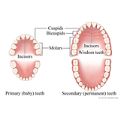Milestones for 3-Year-Olds
Topic Overview
Children usually progress in a natural, predictable sequence from one developmental milestone to the next. But each child grows and gains skills at his or her own pace. Some children may be advanced in one area, such as language, but behind in another, such as sensory and motor development.
Milestones usually are categorized into five major areas: physical growth, cognitive development, emotional and social development, language development, and sensory and motor development.
Physical growth and development
Most children by age 3:
- Have gained about 4.4 lb (2 kg) and grown about 3 in. (8 cm) since their second birthday.
- Begin to look leaner as their prominent belly gradually flattens.
- Have a complete set of baby teeth.
To see the high and low percentiles for normal weight and growth, go to www.cdc.gov/growthcharts.
Thinking and reasoning (cognitive development)
Most children by age 3:
- Know their own name, age, and gender.
- Follow 2- to 3-step instructions, such as “pick up your doll and put it on your bed next to the teddy bear.”
- Grasp the concept of “two.” For example, they understand when they have two cookies rather than one. But they usually aren’t yet able to understand the concept of higher numbers.
- Memorize a string of numbers rather than actually count. The same is true of the alphabet. A child may say the letters from memory but may not be able to recognize a written letter singled out from the others. But some 3-year-olds show great interest in and ability with numbers, counting, and the alphabet.
- Enjoy working with puzzles that have 3 or 4 pieces. Most children can also sort objects by shape and color.
- Have active imaginations and a rich fantasy life. For example, they may imagine that their toys or stuffed animals can talk and play with them.
Emotional and social development
Most children by age 3:
- Experience a wide range of emotions.
- Separate easily from their parents.
- Express affection openly. They may show affection for familiar playmates spontaneously.
- Understand the concept of “mine” and “yours.” They may have trouble sharing toys at times or have conflicts when playing with others.
- Can identify a person as a boy or girl. But they do not yet fully understand the distinctions between genders.
- Are interested in toilet training. Many stay dry when they are awake.
Language development
Most children by age 3:
- Learn new words quickly. Most recognize and can name common objects.
- Use plurals, such as “books” for more than one book. Also most children use pronouns (I, you, me, we, they) and use complete sentences of 4 to 5 words. Strangers understand most of what they say.
- Often ask “why” and “what.”
- Understand most of what they hear.
- Are not yet able to fully express their feelings with words.
Sensory and motor development
Most children by age 3:
- Develop more large muscle movements (gross motor skills). These generally include:
- Running.
- Climbing. Most children alternate feet when going up or down stairs.
- Jumping in place.
- Pedaling a tricycle.
- Kicking a ball.
- Bending over easily.
- Develop more small muscle coordination, which involves their hands and fingers (fine motor skills). These skills may include:
- Copying a circle.
- Using a cup, fork, and spoon with ease.
- Getting dressed, although they usually still need some help managing buttons, zippers, and snaps.
- Turning the pages of a book one at a time.
- Building a tower of 6 blocks.
- Holding pens and pencils using thumb and forefinger.
- Screwing and unscrewing lids.
Current as of: December 12, 2018
Author: Healthwise Staff
Medical Review:John Pope, MD, MPH – Pediatrics & Kathleen Romito, MD – Family Medicine & Louis Pellegrino, MD – Developmental Pediatrics
This information does not replace the advice of a doctor. Healthwise, Incorporated, disclaims any warranty or liability for your use of this information. Your use of this information means that you agree to the Terms of Use. Learn how we develop our content.


